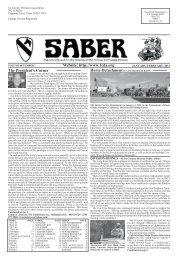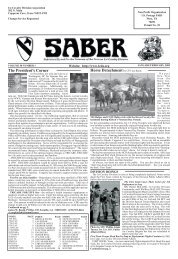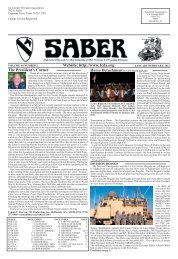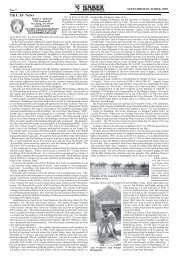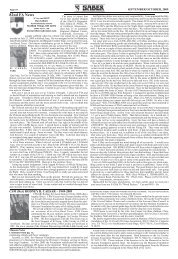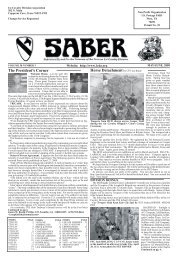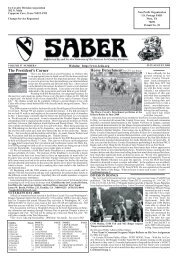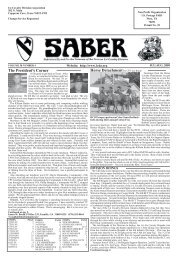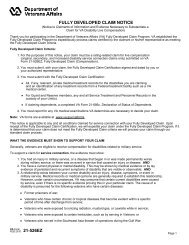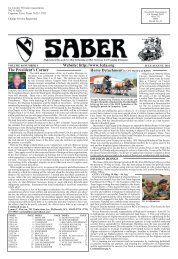May Jun '10 Saber.indd - First Cavalry Division Association
May Jun '10 Saber.indd - First Cavalry Division Association
May Jun '10 Saber.indd - First Cavalry Division Association
Create successful ePaper yourself
Turn your PDF publications into a flip-book with our unique Google optimized e-Paper software.
MAY/JUNE, 2010<br />
TOYA MARU SURVIVOR’S STORY by Peter O’Brien<br />
On March 29th, 2010, through<br />
the amazing earth-shrinking<br />
miracle of the Internet, I found<br />
and spoke with the lone 1st<br />
<strong>Cavalry</strong> <strong>Division</strong> Artillery survivor<br />
of the Toya Maru ferry<br />
disaster of September 26, 1954.<br />
The ferry had sailed from Hakodate,<br />
Hokkaido, with about<br />
1,309 passengers including 36<br />
members of the 1st Cav <strong>Division</strong><br />
Artillery’s advance party<br />
being sent south to set up a new duty station at Camp Younghans, near Sendai<br />
on Honshu. The four and a half hour ferry ride to Aomori, Honshu, was to be<br />
the first leg of the trip for the advance party. The battalions were to move to<br />
Honshu with their equipment on LSTs and disembark further south at Sendai for<br />
the 40-mile drive to Younghans.<br />
PFC Francis P. GOEDKEN, 99th Field Artillery, HQ Battery 1953-55, was on<br />
an upper glassed-in deck of Toya Maru with several other 99th troopers when,<br />
at about 2100 hrs, he and those gathered there were told by an unknown 99th<br />
Officer to don their life jackets and remove their shoes. Winds were howling and<br />
enormous waves loomed ahead but they were unaware that they were weathering<br />
a typhoon. The soldiers had earlier had supper aboard the ship when seas were<br />
relatively calm. Japanese train travelers were still sitting in their trains on the<br />
train deck of the ship. One of the GI’s, sensing the growing danger, said, “let’s<br />
pray.”<br />
It was soon apparent that the ship was losing headway and taking on water.<br />
The rising water in the ship compressed the air in the upper decks, causing the<br />
large glass window ports to pop out. The anchor was put out but it failed and the<br />
ship grounded which negated all efforts to stabilize her. Buffeted by the huge<br />
waves and typhoon winds she capsized at 2243 hrs, just several hundred meters<br />
off the coast of Hakodate, Hokkaido.<br />
The last thing Frank remembered before being washed out of one of the ports<br />
was the sound of two GI’s praying. Once in the water, not knowing how he got<br />
there and despite the pitch-black night, he spotted a life raft that had been washed<br />
off the deck. An elderly Japanese man was sitting on it and Frank swam to it.<br />
Frank climbed aboard but soon one of the enormous waves washed them off.<br />
They remounted the raft, only to be washed off again. In the second displacement,<br />
GOEDKEN broke his elbow when his arm became entangled in the raft’s<br />
rope lines. Drifting now in the inky darkness he saw the lights of a ship nearby,<br />
but it was not in a life-saving mode. The waves battered him against the steel<br />
MEDAL OF HONOR<br />
CARMEL B. HARVEY, JR.<br />
Rank and organization: Specialist Fourth Class,<br />
U.S. Army, Company B, 1st Battalion, 5th <strong>Cavalry</strong>, 1st<br />
<strong>Cavalry</strong> <strong>Division</strong> (Airmobile).<br />
Place and date: Binh Dinh Province, Republic of<br />
Vietnam, 21 <strong>Jun</strong>e 1967.<br />
Entered service at: Chicago, Ill.<br />
Born: 6 October 1946, Montgomery, W. Va.<br />
Citation<br />
For conspicuous gallantry and intrepidity in action at<br />
the risk of his life above and beyond the call of duty. SPC4 Harvey<br />
distinguished himself as a fire team leader with Company B,<br />
during combat operations. Ordered to secure a downed helicopter,<br />
his platoon established a defensive perimeter around the aircraft,<br />
but shortly thereafter a large enemy force attacked the position<br />
from 3 sides. SPC4 Harvey and 2 members of his squad were in<br />
a position directly in the path of the enemy onslaught, and their<br />
location received the brunt of the fire from an enemy machine<br />
gun. In short order, both of his companions were wounded, but<br />
SPC4 Harvey covered this loss by increasing his deliberate rifle fire at the foe.<br />
The enemy machine gun seemed to concentrate on him and the bullets struck the<br />
ground all around his position. One round hit and armed a grenade attached to<br />
his belt. Quickly, he tried to remove the grenade but was unsuccessful. Realizing<br />
the danger to his comrades if he remained and despite the hail of enemy fire, he<br />
jumped to his feet, shouted a challenge at the enemy, and raced toward the deadly<br />
machine gun. He nearly reached the enemy position when the grenade on his belt<br />
exploded, mortally wounding SPC4 Harvey, and stunning the enemy machine gun<br />
crew. His final act caused a pause in the enemy fire, and the wounded men were<br />
moved from the danger area. SPC4 Harvey’s dedication to duty, high sense of<br />
responsibility, and heroic actions inspired the others in his platoon to decisively<br />
beat back the enemy attack. His acts are in keeping with the highest traditions of<br />
the military service and reflect great credit upon himself and the U.S. Army.<br />
FOUNDATION PROVIDES SCHOLARSHIPS<br />
The Foundation of the 1st <strong>Cavalry</strong> <strong>Division</strong> <strong>Association</strong> offers scholarships to<br />
eligible applicants who are attending accredited educational institutions. Currently,<br />
scholarship grants of up to $1,200 are offered annually and pay up to a<br />
total of $4,800 for four years of schooling.<br />
The scholarship program was initiated by the <strong>Association</strong> in 1967 during the<br />
Vietnam War in response to requests from the Sergeants Major of the <strong>Division</strong><br />
who committed their support to perpetuation of the program. A trust agreement<br />
was signed 16 August, 1968 establishing the Foundation. Since that time, no<br />
child has been turned away for lack of funds. Between the generous donations<br />
of <strong>Association</strong> members and a good investment program the <strong>Cavalry</strong> has taken<br />
care of its own.<br />
Children of Troopers that were killed in action or are totally and permanently<br />
disabled due to wounds or diseases contracted while serving with the division<br />
are eligible for scholarships. Children of 1st <strong>Cavalry</strong> <strong>Division</strong> <strong>Association</strong><br />
members who die while serving with the 1st <strong>Cavalry</strong> <strong>Division</strong> in peacetime are<br />
also eligible. Additionally, active duty soldiers, spouses and children of soldiers<br />
who currently serve in the division and are members of the 1st <strong>Cavalry</strong> <strong>Division</strong><br />
<strong>Association</strong> are also eligible.<br />
Page 12<br />
hull of the silent ship several times as he was being washed toward the stern.<br />
Fearing the suction of the propeller he managed to pull away and a wave hurled<br />
him further astern. Soon, without any real effort on his part, he felt the ground<br />
beneath his feet as he was being miraculously washed up on the storm-lashed<br />
Nanae Beach, near Hakodate, Hokkaido.<br />
Walking along the beach he came to an Army Piper Cub that was tied down<br />
on the hard packed sand. Apparently the survivor of an emergency landing,<br />
the plane was intact and Frank considered riding-out the storm in it. He soon<br />
changed his mind, however, and headed inland where he found a large warehouse<br />
and hunkered down there until he was found and taken to a local hospital where<br />
his arm was treated. The next morning his Japanese nurse told him he was very<br />
lucky to have survived, and that’s when Frank learned what had happened to the<br />
1,159 people who didn’t make it. Only 150 survived.<br />
Frank recuperated in an Army hospital on Hokkaido. When released, he was<br />
debriefed by a group of 1st Cav generals. Frank told them what he had experienced<br />
and about the unknown 99th officer who had coolly issued orders as they<br />
were gathered on the upper deck in that ferocious storm. Frank suggested that<br />
whoever he was, he deserved a medal. That officer was 2LT George A. VAIL-<br />
LANCOURT, 99th Field Artillery, Battery C, who was posthumously awarded<br />
the Soldier’s Medal. The football field at Younghans was dedicated a year later<br />
to LT VAILLANCOURT and the others who lost their lives that night.<br />
Soon after the sinking, the ship owners offered Frank 100,000 yen but he<br />
declined. He was informed by a friend that to decline this face-saving gesture<br />
by the genuinely sorry ship owners was not good Japanese manners and might<br />
offend, so he relented and took the money; about $280 at that time.<br />
After his discharge in April, 1955, Frank GOEDKEN returned to his hometown<br />
of Dubuque, Iowa and found a job as a pattern maker at John Deere’s Dubuque<br />
Works where he stayed 55 years. Now retired, the 77 year old, and his wife Esther<br />
enjoy the quiet peace of small town America in nearby Zwingle, Iowa, population<br />
120. Frank is very much interested in any efforts for a Memorial to those<br />
comrades he lost that long ago night of September 26, 1954. He remembers the<br />
typhoon and near drowning vividly to this day. Frank may be reached at 10226<br />
Arensdorf Road, Zwingle, IA 52079, tel (563) 773 2618.<br />
While the photo of the Memorial to LT VAILLANCOURT at Camp Younghans<br />
shows an Honor Roll of those lost that night, it’s too small to read. So, if anyone<br />
has a list of those men, please share it with Jim Miller where it can be available<br />
to all interested 1st Cav veterans.<br />
I also spoke with Lloyd Pitman recently. He sent in the photo of the Toya<br />
Maru and as a 1949-50 member of the 99th he too is very interested in any Toya<br />
Maru memorial.<br />
Peter O’Brien, PO Box 133, Foxboro, MA 02035, HQ, 61st FA, 1954-55.<br />
MEDAL OF HONOR<br />
EDGAR L. McWETHY, JR.<br />
Rank and organization: Specialist Fifth Class, U.S.<br />
Army, Company B, 1st Battalion, 5th <strong>Cavalry</strong>, 1st <strong>Cavalry</strong><br />
<strong>Division</strong> (Airmobile).<br />
Place and date: Binh Dinh province, Republic of<br />
Vietnam, 21 <strong>Jun</strong>e 1967.<br />
Entered service at: Denver, Colo.<br />
Born: 22 November 1944, Leadville, Colo.<br />
Citation<br />
For conspicuous gallantry and intrepidity in action at<br />
the risk of his life above and beyond the call of duty. Serving<br />
as a medical aidman with Company B, SPC5 McWethy accompanied<br />
his platoon to the site of a downed helicopter. Shortly<br />
after the platoon established a defensive perimeter around the<br />
aircraft, a large enemy force attacked the position from 3 sides<br />
with a heavy volume of automatic weapons fire and grenades.<br />
The platoon leader and his radio operator were wounded almost<br />
immediately, and SPC5 McWethy rushed across the fire-swept<br />
area to their assistance. Although he could not help the mortally<br />
wounded radio operator, SPC5 McWethy’s timely first aid enabled the platoon<br />
leader to retain command during this critical period. Hearing a call for aid, SPC5<br />
McWethy started across the open toward the injured men, but was wounded in the<br />
head and knocked to the ground. He regained his feet and continued on but was<br />
hit again, this time in the leg. Struggling onward despite his wounds, he gained<br />
the side of his comrades and treated their injuries. Observing another fallen rifleman<br />
Lying in an exposed position raked by enemy fire, SPC5 McWethy moved<br />
toward him without hesitation. Although the enemy fire wounded him a third<br />
time, SPC5 McWethy reached his fallen companion. Though weakened and in<br />
extreme pain, SPC5 McWethy gave the wounded man artificial respiration but<br />
suffered a fourth and fatal wound. Through his indomitable courage, complete<br />
disregard for his safety, and demonstrated concern for his fellow soldiers, SPC5<br />
McWethy inspired the members of his platoon and contributed in great measure<br />
to their successful defense of the position and the ultimate rout of the enemy<br />
force. SPC5 McWethy’s profound sense of duty, bravery, and his willingness to<br />
accept extraordinary risks in order to help the men of his unit are characteristic of<br />
the highest traditions of the military service and reflect great credit upon himself<br />
and the U.S. Army.<br />
The first scholarship grant was awarded in 1973. Initially grants were for<br />
$400 per year and have been raised incrementally over the years. The grants<br />
were increased from $1,000 per year to $1,200 per year in <strong>Jun</strong>e, 2008. As of<br />
Donations to the Foundation by <strong>Association</strong> members are gratefully accepted<br />
and are invested and managed by the Foundation Trustees to support this worthy<br />
program.<br />
Undergraduate students must be enrolled for a minimum of 12 semester hours<br />
to receive a full grant. Students enrolled in a Masters Degree program must<br />
maintain a semester total of 5 hours and those enrolled in Doctorate Degree programs<br />
must maintain 3 hours for a full grant. A course of instruction deemed by<br />
the trustees to be of a frivolous nature and not normally leading to a career or job<br />
opportunity generally disqualifies an applicant from receiving a scholar<br />
ship grant.<br />
Continued on pg. 17



